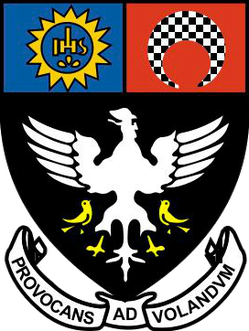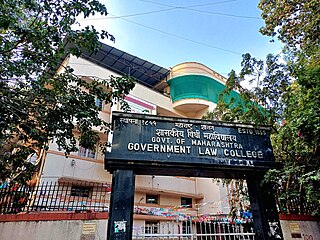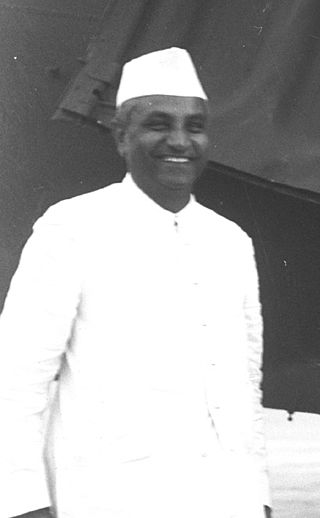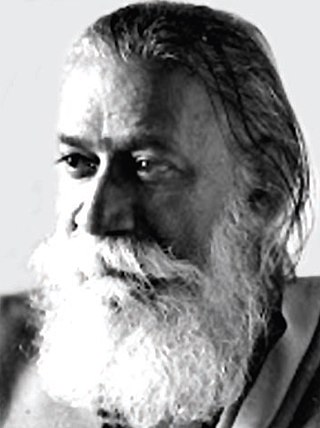
Joseph Rudyard Kipling was an English novelist, short-story writer, poet, and journalist. He was born in British India, which inspired much of his work.

The Indian Institute of Technology Bombay is a public research university and technical institute in Mumbai, Maharashtra.
The Grant Government Medical College is a public medical college located in Mumbai, India. It is affiliated to the Maharashtra University of Health Sciences. Founded in 1845, it is one of the oldest medical colleges in South Asia. Its clinical affiliate is Sir J.J. Group of Hospitals, a conglomerate of four hospitals in South Mumbai including Sir J.J. Hospital, St George Hospital, Gokuldas Tejpal Hospital and Cama and Albless Hospital.

Fergusson College is an autonomous public-private college offering various courses in the streams of arts and science in the city of Pune, India. It was founded in 1885 by the Vaman Shriram Apte, Bal Gangadhar Tilak, Vishnushashtri Chiplunkar, Mahadeo Ballal Namjoshi and Gopal Ganesh Agarkar. Professor Vaman Shivram Apte was its first principal. Social reformer, journalist, thinker and educationist Gopal Ganesh Agarkar served as the second principal from August 1892, till his death in June 1895.

St. Xavier's College is a private, Catholic, autonomous higher education institution run by the Bombay Province of the Society of Jesus in Mumbai, Maharashtra, India. It was founded by the Jesuits on January 2, 1869. The college is affiliated with the University of Mumbai offering undergraduate and postgraduate courses in Arts, Science, Commerce and Management. Xavier's was the first college to be granted autonomy by the University of Mumbai in 2010. In 2006, St. Xavier's was awarded the 'A+' grade by National Assessment and Accreditation Council (NAAC).

John Lockwood Kipling was an English art teacher, illustrator and museum curator who spent most of his career in India. He was the father of the author Rudyard Kipling.

Elphinstone College is one of the constituent colleges of Dr. Homi Bhabha State University, a state cluster university. Established in 1823, it is one of the oldest colleges in Mumbai. It played a major role in shaping and developing the educational landscape of the city. It also played a pivotal role in the inception of the University of Mumbai.

Raj Shrikant Thackeray is an Indian politician and the founding chairperson of Maharashtra Navnirman Sena (MNS), a regional political party. Raj was a former member of Shiv Sena till he founded MNS in 2006. He is the nephew of Balasaheb Thackeray.

The Sir Jamsetjee Jeejeebhoy School of Art is the oldest art institution in Mumbai, India, and is affiliated with the University of Mumbai. The school grants bachelor's (B.F.A) degrees in Painting, ceramic, Metal work, Interior decoration, Textile design and Sculpture as well as Master's degrees (M.F.A) in Portraiture, Creative Painting, Murals, Sculpture, and Printmaking.

The Bombay Scottish School, Mahim, popularly known as Scottish, is a private, Christian co-educational day school located at Mahim West in Mumbai, India. The institution was established in 1847 by Scottish Christian missionaries under the name Scottish Female Orphanage. Bombay Scottish School, Powai is an affiliate of this institution.
The Marine Engineering and Research Institute (MERI), formerly known as the Directorate of Marine Engineering Training (DMET), now known as Indian Maritime University - Kolkata Campus and Mumbai Port Campus, is India's national institute and one of the institutes for the training of Marine Engineers and Polyvalent Officers.

The Government Law College, Mumbai,, India, founded in 1855, is the oldest law school in Asia. The college, affiliated to the University of Mumbai, is run by the Government of Maharashtra.

Sir J. J. College of Architecture is an architecture school located in downtown Mumbai (Bombay), affiliated to University of Mumbai in the state of Maharashtra, India. Sharing its premises with Sir J. J. School of Art and Sir J.J. School of Applied Art, it is now rented from Government of Maharashtra as per the deed of Sir Jamsetjee Jejeebhoy. The college occupies two buildings, housing the teaching and non teaching departments along with a small workshop area and canteen space. The Old Building is one of the heritage buildings in the campus.

Jivraj Narayan Mehta was an Indian politician and the first Chief Minister of Gujarat. He also served as the first "Dewan" of the erstwhile Baroda state, and Indian high commissioner to the United Kingdom from 1963 to 1966.

Dadabhai Naoroji Road (D.N.Road), a North–South commercial artery road, in the Fort business district in South Mumbai of Maharashtra, India, is the nerve centre of the city, starting from the Mahatma Phule Market ,linking Chhatrapati Shivaji Maharaj Terminus, leads to the Hutatma Chowk at the southern end of the road. This entire stretch of the road is studded with Neo–Classical and Gothic Revival buildings and parks built in the 19th century, intermingled with modern office buildings and commercial establishments.
Sophia College (Autonomous) is an undergraduate women's college established in 1941 by Society of the Sacred Heart of Jesus. It is affiliated to the University of Mumbai. The governing body of The Society for the Higher Education of Women in India runs the college. The Religious Sisters of the Sacred Heart of Jesus and lay staff form the staff of the college. Sophia, as the name suggests, stands for Wisdom in Greek Σοφία.

Sambanand Monappa Pandit was an Indian painter from Karnataka, popular in the school of Realism in contrast to the contemporaneous net-traditionalist Bengal Renaissance and other Indian modern art movements of his time. Most of his subjects oscillated between events from classical Indian literature including the Ramayana, the Mahabharata, the Puranas, and the contemporary cinema of his times. He infused a rare blend of artistic virtuosity and filmi glamour to his portrayal of romantic characters like Radha-Krishna, Nala-Damayanti, and Viswamitra-Menaka as also the many heroes and heroines of Hindi cinema. In addition to his critically acclaimed masterpieces he also illustrated many popular film posters, film magazines and various other publications in what can collectively be termed as calendar art. His works remain hugely popular even today. His mythological paintings and calendar art have been collected widely. He is also widely celebrated in the Indian calendar industry for his "realistic" depiction of themes from Hindu mythology. In these paintings he emphasised the physical forms of the heroes, heroines, gods and goddesses in marked contrast to traditional and classical styles of Indian painting. In his paintings, Pandit depicted his subjects as handsome, muscular, valorous men and sensuously beautiful, voluptuous women set in surroundings suggestive of cinema settings and sceneries.

Institute of Chemical Technology (ICT) is a public deemed university in Mumbai, India. The institute also has campuses at Bhubaneswar, Odisha and Jalna,. It is focused on training and research in the fields of chemical engineering, chemical technology, and pharmaceutical sciences. It was established in 1933 and was granted deemed university status in 2008, making it the only state-funded deemed university in India. On 12 February 2018 it was given the status of Category 1 institute with graded autonomy by the Ministry of Human Resource Development and the University Grants Commission (India). It is also an institute with a special status as mentioned in SECTION IV of the Report of the Empowered Expert Committee in 2018.

Pralhad Anant Dhond (1908–2001) was an Indian painter and art educator.
Gitanjali Rao is an Indian theatre actress, animator and film maker.
















